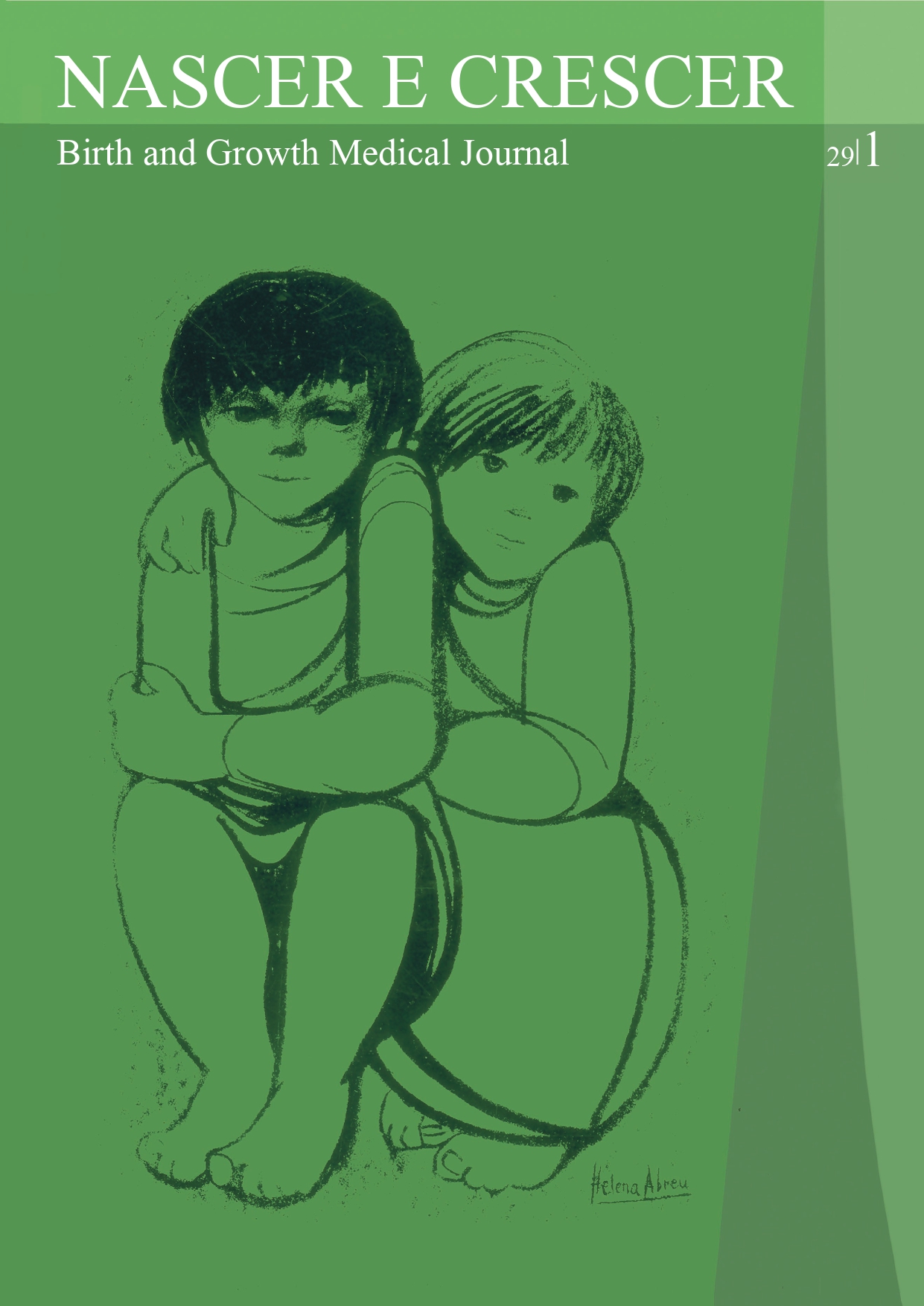Edema insulínico em idade pediátrica - caso clínico
DOI:
https://doi.org/10.25753/BirthGrowthMJ.v28.i2.15709Palavras-chave:
crianças e adolescentes, complicação, diabetes mellitus tipo 1, insulina, edemaResumo
Introdução: Edema insulínico é uma entidade rara associada a melhoria do controlo glicémico logo após o diagnóstico de diabetes ou após um período de omissão de insulina. Os achados clínicos variam de edema leve a casos graves de insuficiência cardíaca e derrame pleural. O diagnóstico é clínico e devem ser excluídas outras causas de edema. Tratando-se de uma condição auto-limitada, não é necessário modificar o esquema de insulina. Em casos mais graves, pode ser necessária terapêutica com diuréticos.
Caso clínico: Uma adolescente de 14 anos de idade foi levada ao Serviço de Urgência por aumento de peso e edema dos membros inferiores com três dias de evolução. Como antecedentes, a jovem tinha sido diagnosticada com diabetes tipo 1 aos nove anos de idade. Mantinha um mau controlo metabólico com necessidade de múltiplas hospitalizações, a última das quais na semana anterior com um valor de hemoglobina glicosilada superior a 15%. No exame físico, observou-se edema dos membros inferiores e ganho ponderal de sete quilos. Não foi observada turgescência da veia jugular, hepatomegalia ou outras formas de edema. A doente encontrava-se hemodinamicamente estável, com diurese dentro do normal. O estudo analítico que incluiu hemograma, ionograma e função renal e hepática foi normal. A análise de urina revelou glicosúria com densidade urinária normal e a radiografia de tórax não mostrou alterações. Foi estabelecido o diagnóstico de edema induzido por insulina e recomendada restrição hídrica e salina. Após três semanas, a doente apresentava resolução completa da sintomatologia.
Conclusão: Apesar de rara, os clínicos devem estar atentos a esta condição, pois na maioria dos casos não requer modificação do esquema insulínico.
Downloads
Referências
Aravamudhan A, Gardner C, Smith C, Senniappan S. Insulin oedema in a child with newly diagnosed diabetes mellitus. European Journal of Pediatrics. 2013; 173:685-7.
Adamo L, Thoelke M. Generalised insulin oedema after intensification of treatment with insulin analogues. BMJ Case Rep. 2013; 2013: bcr2012007037.
Chaker F, Yazid M, Chihaoui M, Rached A, Slimane H. Insulin-Induced Edema: An Unusual Complication in a Patient With Diabetic Ketosis. Tunis Med. 2017; 95:142-4.
Lawrence JR. Diabetic (insulin) oedema. BMJ. 1979; 2:445.
Kan Y, Anno T, Kawasaki F, Takai M, Shigemoto R, Kaneto H, et al. Bilateral lower limb edema induced by rapid improvement of glycemic control with insulin therapy in a subject with poorly controlled type 2 diabetes. Acta Diabetologica. 2017; 54:611-3.
Klisic J, Hu M, Nief V, Reyes L, Fuster D, Moe O, et al. Insulin activates Na+/H+ exchanger 3: biphasic response and glucocorticoid dependence. American Journal of Physiology-Renal Physiology. 2002; 283:F532-9.
Kalambokis G, Tsatsoulis A, Economou G, Tsianos E. A case of insulin edema with inappropriate hyperaldosteronism. Journal of Endocrinological Investigation. 2004; 27:957-60.
Chelliah A, Burge MR. Insulin edema in the twenty-first century: review of the existing literature. J Investig Med 2004; 52:104–8.
Goturu A, Jain N, Lewis I. Bilateral cataracts and insulin oedema in a child with type 1 diabetes mellitus. Case Reports. 2013; 2013:bcr2012008235.
Bas V, Cetinkaya S, Yilmaz Agladioglu S, Peltek Kendirci H, Bilgili H, Yildirim N, et al. Insulin Oedema in Newly Diagnosed Type 1 Diabetes Mellitus. Journal of Clinical Research in Pediatric Endocrinology. 2010; 2:46-8.
Greco D. Severe Weight Gain and Generalized Insulin Edema after the Starting of an Insulin Pump. Canadian Journal of Diabetes. 2015; 39:21-3.
Rothacker K, Kaye J. Insulin oedema and treatment-induced neuropathy occurring in a 20-year-old patient with Type 1 diabetes commenced on an insulin pump. Diabetic Medicine. 2013; 31:e6-e10.
Downloads
Publicado
Como Citar
Edição
Secção
Licença
Copyright e Direitos dos Autores
Todos os artigos publicados na Revista Nascer e Crescer – Birth and Growth Medical Journal são de acesso aberto e cumprem os requisitos das agências de financiamento ou instituições académicas. Relativamente à utilização por terceiros a Nascer e Crescer – Birth and Growth Medical Journal rege-se pelos termos da licença Creative Commons "Atribuição - Uso Não-Comercial - (CC-BY-NC)"".
É da responsabilidade do autor obter permissão para reproduzir figuras, tabelas, etc. de outras publicações.
Juntamente com a submissão do artigo, os autores devem enviar a Declaração de conflito de interesses e formulário de autoria. Será enviado um e-mail ao autor correspondente, confirmando a receção do manuscrito.
Os autores ficam autorizados a disponibilizar os seus artigos em repositórios das suas instituições de origem, desde que mencionem sempre onde foram publicados e de acordo com a licença Creative Commons.


